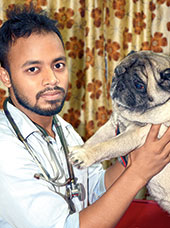
Bringing a puppy into the family is a joyous and exciting occasion. And since the dog would now be a member of the family it is natural to want him to be healthy and friendly.
The first-born in a litter is considered the healthiest but when going to choose a pup, you will probably not be told which the pick of the litter is. In such a case, you can follow some guidelines that would help you make the crucial choice.
Your lifestyle- The first step is a step back. Before picking a pup you need to check if your lifestyle would be comfortable for a dog. Ask if you are willing and able to spend money and time on the puppy.
While money would buy his food, medicines etc, your time is invaluable in his upbringing. You may love dogs but if you cannot take him for walks at least twice a day, you should forget about getting one. Dogs that don’t get exercise suffer from gastrointestinal problems. If you can’t go out yourself, hire someone to walk him.
If school and work keeps everyone in your family out the whole day, you should also not think of getting a puppy. Neglected dogs often turn ferocious. It would be fine if a senior citizen stays with the dog during the day while the rest of the family returns in the evenings and plays with him.
.jpg)
Your lifestyle will also determine the right breed for you. A family may love St. Bernards but if they live in a small apartment, it would be torturous for a dog of a giant breed to live there. A toy breed like Spitz or Pomeranian would be ideal for flats (see box).
Family history- Once you’ve decided on the breed, start your research. Ask for the family history of the litter you plan to pick a pup from.
.jpg)
Information about the puppy’s father is rarely available in Calcutta. This is because the breeder who owns the bitch usually gets her mated with a stud he has heard about and contacted. They may meet just once during the mating and never again. In such a case, it is difficult to trace the father’s details.
So make sure you read up on the mother. The mother shouldn’t appear thin or weak and should not suffer from hip dysplasia. This is a condition where the hip cartilage wears off and leads to deformity in the legs. In 80 per cent cases, if the mother has this, the puppy gets it too. It is most common in Labradors, Golden Retrievers and German Shepherd Dogs (GSD).
Also check that the mother doesn’t have sugar or any ectoparasites like ticks and mites because they would spread to the pup. And if the puppy gets bitten by a particular type of these bugs, it can get ehrlichiosis. This is a very serious condition in pups and at present is common in south Calcutta and Howrah.
Age of the pup- Never take home a pup before it is eight weeks old. This is because the mortality rate of puppies is high before that. Pups open their eyes around 14 days after birth and their weaning period is three weeks. So by the time it is eight weeks old, the pup is strong enough to be adopted.
Health of the pup- Check the puppy’s eyes. They should be bright and clear without any discharge. The eyes mustn’t look drowsy.

Ideally you should check the dog’s temperature to ensure it is normal. Normal temperature for a puppy would be between 101° and 102°F but in summer, it could go up to 103°F and in winter come down to 100°F.
The dog should be free from ectoparasites, have no diarrhoea and no nasal secretion as this could be an early sign of distemper. The pup’s coat should be shiny and smooth. If it’s rough it could mean that the dog isn’t being dewormed adequately. Vaccines must have been started appropriately and should be administered by a certified vet.
Often breeders give vaccines themselves but they are not qualified to do so. The dog’s temperature needs to be measured, deworming needs to be done and the dog should be free from any disease before getting administered a vaccine, but breeders neither know nor care to check these steps.
Tell-tale signs- It is too early to gauge the temperament of a dog by watching it at eight weeks of age, but then their temperament is usually determined by their upbringing later on.
Still, look for the playful puppies in the litter. They must be eating well and have a good appetite.
In puppies of large breeds, the forelimbs should be more developed than the hindlimbs. They should appear thicker. And the ideal shape of an eight-week-old puppy should be roundish, no matter what the size and breed. They shouldn’t appear puny.
Popular breeds for:
•Apartments- Spitz, Pug, Pomeranian, Lhasa Apso, Beagle
•Bungalows- Labrador, Golden Retriever, German Shepherd Dog
•Farm houses- St Bernard, Great Dane
(The author is a vet at Animel Planet, BD Block)










